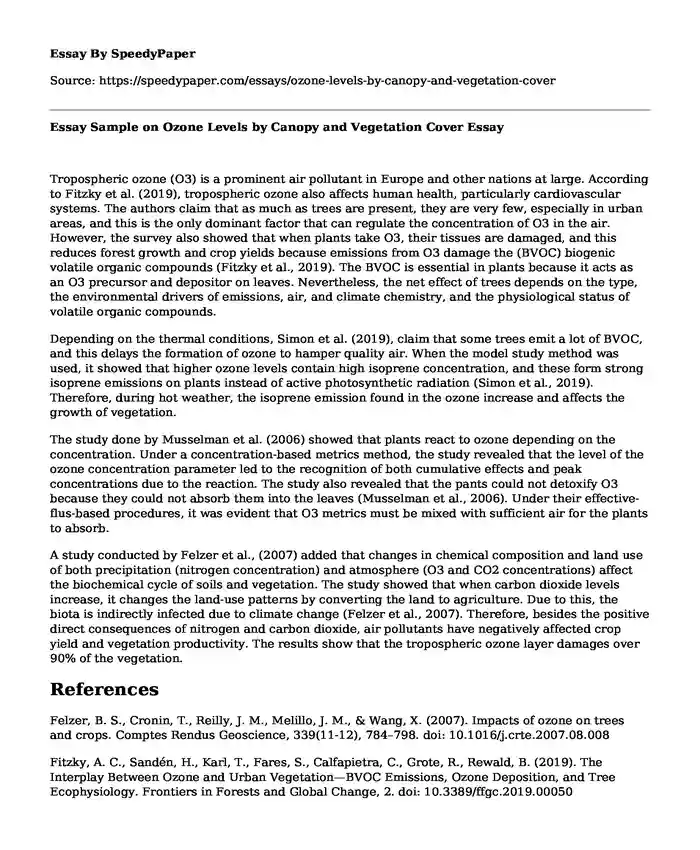
| Essay type: | Analytical essays |
| Categories: | Ecology Chemistry Air pollution |
| Pages: | 3 |
| Wordcount: | 552 words |
Tropospheric ozone (O3) is a prominent air pollutant in Europe and other nations at large. According to Fitzky et al. (2019), tropospheric ozone also affects human health, particularly cardiovascular systems. The authors claim that as much as trees are present, they are very few, especially in urban areas, and this is the only dominant factor that can regulate the concentration of O3 in the air. However, the survey also showed that when plants take O3, their tissues are damaged, and this reduces forest growth and crop yields because emissions from O3 damage the (BVOC) biogenic volatile organic compounds (Fitzky et al., 2019). The BVOC is essential in plants because it acts as an O3 precursor and depositor on leaves. Nevertheless, the net effect of trees depends on the type, the environmental drivers of emissions, air, and climate chemistry, and the physiological status of volatile organic compounds.
Depending on the thermal conditions, Simon et al. (2019), claim that some trees emit a lot of BVOC, and this delays the formation of ozone to hamper quality air. When the model study method was used, it showed that higher ozone levels contain high isoprene concentration, and these form strong isoprene emissions on plants instead of active photosynthetic radiation (Simon et al., 2019). Therefore, during hot weather, the isoprene emission found in the ozone increase and affects the growth of vegetation.
The study done by Musselman et al. (2006) showed that plants react to ozone depending on the concentration. Under a concentration-based metrics method, the study revealed that the level of the ozone concentration parameter led to the recognition of both cumulative effects and peak concentrations due to the reaction. The study also revealed that the pants could not detoxify O3 because they could not absorb them into the leaves (Musselman et al., 2006). Under their effective-flus-based procedures, it was evident that O3 metrics must be mixed with sufficient air for the plants to absorb.
A study conducted by Felzer et al., (2007) added that changes in chemical composition and land use of both precipitation (nitrogen concentration) and atmosphere (O3 and CO2 concentrations) affect the biochemical cycle of soils and vegetation. The study showed that when carbon dioxide levels increase, it changes the land-use patterns by converting the land to agriculture. Due to this, the biota is indirectly infected due to climate change (Felzer et al., 2007). Therefore, besides the positive direct consequences of nitrogen and carbon dioxide, air pollutants have negatively affected crop yield and vegetation productivity. The results show that the tropospheric ozone layer damages over 90% of the vegetation.
References
Felzer, B. S., Cronin, T., Reilly, J. M., Melillo, J. M., & Wang, X. (2007). Impacts of ozone on trees and crops. Comptes Rendus Geoscience, 339(11-12), 784–798. doi: 10.1016/j.crte.2007.08.008
Fitzky, A. C., Sandén, H., Karl, T., Fares, S., Calfapietra, C., Grote, R., Rewald, B. (2019). The Interplay Between Ozone and Urban Vegetation—BVOC Emissions, Ozone Deposition, and Tree Ecophysiology. Frontiers in Forests and Global Change, 2. doi: 10.3389/ffgc.2019.00050
Musselman, R., Lefohn, A., Massman, W., & Heath, R. (2006). A critical review and analysis of the use of exposure- and flux-based ozone indices for predicting vegetation effects. Atmospheric Environment, 40(10), 1869–1888. doi: 10.1016/j.atmosenv.2005.10.064
Simon, H., Fallmann, J., Kropp, T., Tost, H., & Bruse, M. (2019). Urban Trees and Their Impact on Local Ozone Concentration—A Microclimate Modeling Study. The Atmosphere, 10(3), 154–177. doi: 10.3390/atmos10030154
Cite this page
Essay Sample on Ozone Levels by Canopy and Vegetation Cover. (2023, Aug 01). Retrieved from https://speedypaper.com/essays/ozone-levels-by-canopy-and-vegetation-cover
Request Removal
If you are the original author of this essay and no longer wish to have it published on the SpeedyPaper website, please click below to request its removal:
- Should U.S Weaponize Space? Free Essay Sample
- Essay Sample for You: An Attack on the Liberal Left and the Dogmatism of Identity Politics
- Free Essay Commemorating Nikola Tesla and the Contribution of His Inventions in the Modern World
- Paper Example. The Health Conditions of the Married and Unmarried People
- Free Essay. Public Awareness on Climate Change
- Why Should Recycling Be Law?: Annotated Bibliography
- Paper on Guidance and Support for President Trump and Mike Pence Presidential Ticket
Popular categories




